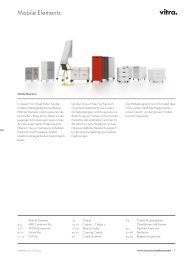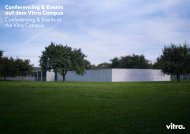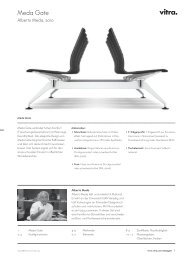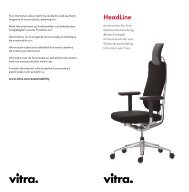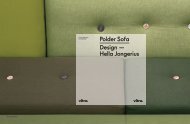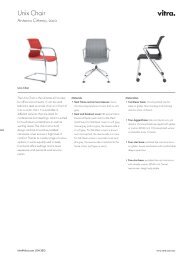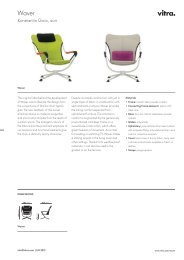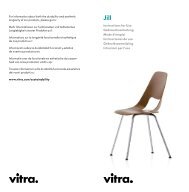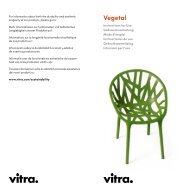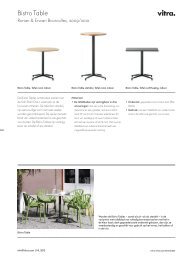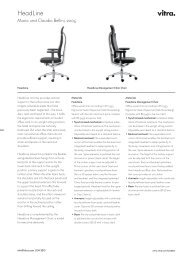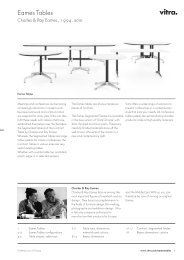Eames Plastic Armchair/ Eames Plastic Side Chair - Vitra
Eames Plastic Armchair/ Eames Plastic Side Chair - Vitra
Eames Plastic Armchair/ Eames Plastic Side Chair - Vitra
Create successful ePaper yourself
Turn your PDF publications into a flip-book with our unique Google optimized e-Paper software.
The design of the <strong>Eames</strong> <strong>Plastic</strong> <strong>Armchair</strong> dates to the year 1948.<br />
It was presented on the first of May as an entry to the ”Low Cost<br />
Furniture Design” competition at the Museum of Modern Art in New<br />
York and subsequently became the first mass-produced synthetic<br />
chair.<br />
The <strong>Eames</strong> <strong>Plastic</strong> <strong>Side</strong> <strong>Chair</strong> is a re-release of the legendary<br />
Fibreglass <strong>Chair</strong>. It is based on the 1950 design. In 1993 <strong>Vitra</strong><br />
ceased production for environmental reasons (fibreglass cannot<br />
be recycled). Thanks to advances in technology and materials it is<br />
now possible to manufacture the seat pan true to the original from<br />
environmentally friendly, recyclable polypropylene.<br />
The comfortable seat pan can be combined with a variety of base<br />
supports and hence can be adapted to a wide range of environments<br />
in which it can be used.<br />
For outdoor use the frame is powder coated and galvanized too.<br />
Special additives in the seat pan slow the fading of colours due<br />
to UV rays. Nevertheless, if the chair is exposed to sunshine for a<br />
longer period of time, the colours may alter somewhat. We recommend<br />
that the chair should not be exposed to sunshine for longer<br />
than is necessary. If the chair is left out of doors for longer periods,<br />
we recommend that it is tilted against the table so that water can<br />
drain from the seating pan. The fully upholstered version is not<br />
suitable for outside use.<br />
DSS and DSS-N are stackable up to 14 chairs on the ground<br />
or a stacking trolley. Fully upholstered version stackable<br />
up to 4 chairs (on the ground) or 10 chairs (on a stacking<br />
trolley).<br />
Der Entwurf des <strong>Eames</strong> <strong>Plastic</strong> <strong>Armchair</strong> stammt aus dem Jahr<br />
1948. Er wurde im Rahmen des Wettbewerbs »Low Cost Furniture<br />
Design« des Museum of Modern Art in New York zum ersten Mal<br />
präsentiert und war im der Folge der erste serienmässig produzierte<br />
Kunststoffstuhl.<br />
Der <strong>Eames</strong> <strong>Plastic</strong> <strong>Side</strong> <strong>Chair</strong> ist die Re-Edition des legendären<br />
Fiber glass <strong>Chair</strong>. Er basiert auf dem Entwurf von 1950. 1993 stellte<br />
<strong>Vitra</strong> die Produktion aus ökologischen Gründen ein (Fiberglass<br />
ist nicht recyclebar). Durch die Entwicklungen in Technik und<br />
Mate rialien ist es heute möglich, die Sitzschale originalgetreu<br />
aus umweltfreundlichem, recycelbarem Polypropylen zu fertigen.<br />
Die bequeme Sitzschale kann mit unterschiedlichen Untergestellen<br />
kombiniert werden und eignet sich so für verschiedenste Einsatzbereiche.<br />
Für den Einsatz im Aussenbereich sind die Gestelle pulverbeschichtet<br />
und zusätzlich verzinkt. Spezielle Additive in der Sitzschale<br />
verlangsamen das Ausbleichen der Farben durch UV-Bestrahlung.<br />
Wird der Stuhl über einen längeren Zeitraum der Sonne ausgesetzt,<br />
kann sich die Farbe dennoch etwas verändern. Wir em pfehlen,<br />
den Stuhl nicht länger als nötig der Sonne auszusetzen.<br />
Steht der Stuhl unbenutzt im Aussenbereich, empfiehlt es sich,<br />
den Stuhl schräg an den Tisch zu lehnen damit das Wasser auf<br />
der Sitzfläche ablaufen kann. Variante Vollpolster nicht für den<br />
Aussenbereich geeignet.<br />
DSS und DSS-N stapelbar bis zu 14 Stühle am Boden oder<br />
auf Stapelwagen. Variante mit Vollpolster stapelbar bis zu<br />
4 Stühle (auf Boden) resp. 10 Stühle (auf Stapelwagen).<br />
L’<strong>Eames</strong> <strong>Plastic</strong> <strong>Armchair</strong> a été créé en 1948 et présenté pour<br />
la première fois dans le cadre du concours « Low Cost Furniture<br />
Design » du Museum of Modern Art à New York. Il fut le premier<br />
siège en plastique produit en série.<br />
L’<strong>Eames</strong> <strong>Plastic</strong> <strong>Side</strong> <strong>Chair</strong> est la réédition de la légendaire Fiberglass<br />
<strong>Chair</strong>. Inspirée de l’œuvre d’origine créée en 1950. En 1993,<br />
<strong>Vitra</strong> arrêta la production pour des raisons écologiques, les fibres<br />
de verre n’étant pas recyclables. Grâce à l‘évolution des techniques<br />
et des matériaux, il est aujourd’hui possible de fabriquer<br />
la coque dans sa forme d‘origine en polypropylène recyclable et<br />
respectueux de l’environnement.<br />
La coque confortable peut être combinée à différents piètements<br />
et ainsi s’intégrer aux environnements les plus divers.<br />
Pour l’usage à l’extérieur, les piètement sont revêtus par poudre<br />
et galvanisés. Des additifs spéciaux dans la coque ralentissent<br />
la décoloration due au rayonnement ultraviolet. La couleur peut<br />
néanmoins subir une légère modification si le siège est exposé<br />
longuement au soleil. Nous recommandons de ne pas exposer<br />
le siège au soleil pendant une période prolongée. Si la chaise est<br />
inutilisée à l‘extérieur, nous recommandons de l‘appuyer contre la<br />
table en position oblique, pour éviter que l‘eau de pluie ne stagne<br />
sur l‘assise. La variante à rembourrage intégral ne convient pas à<br />
l‘usage extérieur.<br />
DSS et DSS-N : Empilage à raison de 14 sièges, au sol ou<br />
sur le chariot díempilage. Variante avec rembourrage<br />
intégral empilable à raison de 4 sièges (au sol) ou 10 sièges<br />
(sur le chariot).



